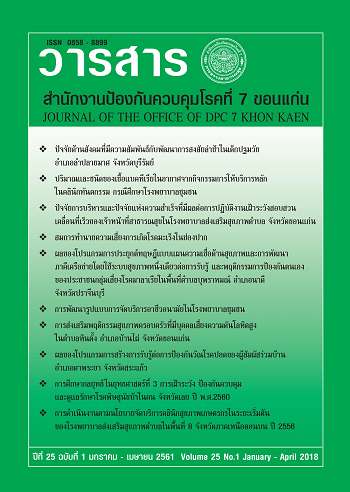Result of Application Health Belief Model and Network Association Development Program Using One Health System for Perception and Behavior among People at Risk to Malaria Disease in Bupram Sub-district, Nadi District,Prachinburi Province.
Keywords:
Malaria Disease, Health Belief Model, One Health System, Behavior ModificationAbstract
This research was a quasi-experimental research with the objective to study the result of application health
belief model and network association development program using the one health system for perception and
behavior of the people at risk to Malaria disease in Bupram sub-district, Nadi district, Prachinburi province. Thesamples were drawn by simple sampling from the population at risk of Malaria disease. The sample groupwas divided into an experimental group and a controlled group, each of which consisted of 48 samples.
The experimental group participated in the activities to change their behavior consisting of appointing the
committee to perform one health operation, providing knowledge Health Belief Model and holding group
activities to exchange knowledge, following up and giving advice by One Health Network Association team, whichlasted 12 weeks. Data was collected before and after the experiment by using the questionnaires. Then, the datawas analyzed with frequency, percentage, mean, standard deviation, Paired t-test and Independent t-test wereused to test the hypotheses.The fndings revealed that after the experiment, the experimental group obtained the scores for perceptionof Malaria disease occurrence, severity of the disease, benefts from preventing themselves from the disease,obstacles from preventing themselves from the disease, and preventive behaviors for Malaria disease higher than prior to the experiment and the controlled group at the signifcance statistic level of (p-value<0.05).The factors of success for this program were a result from the integration of potential improvement for the network association by using one health system and participation of the association to promote the disease prevention operation in the area in order to generate perception and understanding which would lead to behavior change and continuous follow-up of the operation in the area.
References
แทรกซ้อนสำหรับบุคลากรสาธารณสุข (ปรับปรุงปีพ.ศ. 2557). กรุงเทพฯ: โรงพิมพ์ชุมนุมสหกรณ์การเกษตรแห่งประเทศไทย; 2557.
2. สำนักโรคติดต่อนำโดยแมลง กรมควบคุมโรคกระทรวงสาธารณสุข. แนวทางการวินิจฉัยและดูแลรักษาโรคไข้มาลาเรีย ประเทศไทย พ.ศ. 2558.กรุงเทพฯ: โรงพิมพ์ชุมนุมสหกรณ์การเกษตรแห่งประเทศไทย; 2558.
3. สำนักงานสาธารณสุขจังหวัดปราจีนบุรี. รายงานสถานการณ์โรคมาลาเรีย ปี 2554–2557.ปราจีนบุรี: สำนักงานสาธารณสุขจังหวัดปราจีนบุรี;2558. (เอกสารอัดสำเนา)
4. สำนักงานสาธารณสุขอำเภอนาดี จังหวัดปราจีนบุรี.สรุปรายงานสถานการณ์โรคมาลาเรีย ปี 2554–2557 อำเภอนาดี จังหวัดปราจีนบุรี; 2558.(เอกสารอัดสำเนา)
5. กรมควบคุมโรค กระทรวงสาธารณสุข. สรุปการดำเนินงานด้านสุขภาพหนึ่งเดียวของประเทศไทย(One Health). นนทบุรี; 2558.
6. Rosentock IM. Historical origins of the HealthBelief Model. Health Educ Monogr 1974; 2:328-35.
7. อรุณ จิรวัฒน์กุล. ชีวสถิติสำหรับงานวิจัยด้านวิทยาศาสตร์สุขภาพ. พิมพ์ครั้งที่ 3. ขอนแก่น.โรงพิมพ์คลังนานาวิทยา; 2548.
8. สำนักโรคติดต่อนำโดยแมลง กรมควบคุมโรคกระทรวงสาธารณสุข. หลักสูตรอบรมการเฝ้าระวังควบคุมเพื่อการยับยั้งการแพร่เชื้อมาลาเรียสำหรับทีม SRRT ระดับตำบล. พิมพ์ครั้งที่ 2. กรุงเทพฯ:โรงพิมพ์ชุมนุมสหกรณ์การเกษตรแห่งประเทศไทย;
2557.
9. Likert. Attitude theory and measurement. NewYork: Wiley & Son; 1967.
10. เดือนนภา ศิริบูรณ์. ผลของโปรแกรมการเรียนรู้แบบมีส่วนร่วมต่อการป้องกันและควบคุมโรคมาลาเรียของตัวแทนครัวเรือนตำบลโดมประดิษฐ์ อำเภอน้ำยืน จังหวัดอุบลราชธานี. SNRUJST 2559; 8(3):292–300.
11. หาญณรงค์ แสงแก. ผลของโปรแกรมสุขศึกษาในการป้องกันและควบคุมโรคไข้เลือดออกของแกนนำครัวเรือน ตำบลเมืองไผ่ อำเภออรัญประเทศ จังหวัดสระแก้ว. วารสารวิจัยราชภัฏพระนคร 2558,10(1): 65-81.
12. พรพิมล ประดิษฐ์, สิริมา มงคลสัมฤทธิ์, เกษร สำเภาทอง. การวิเคราะห์อภิมานปัจจัยที่มีความสัมพันธ์กับพฤติกรรมการป้องกันโรคไข้มาลาเรียตามทฤษฎีแบบแผนความเชื่อด้านสุขภาพ. วารสารวิจัยทางวิทยาศาสตร์สุขภาพ 2559; 10(2):92–103.
13. Becker M. The Health Belief Model and personal health behavior. Thorofare, NJ:Charles
B. Slack; 1974.
14. จีระศักดิ์ กรมาทิตย์สุข. ผลของโปรแกรมสร้างเสริมพลังชุมชนในการป้องกันโรคมาลาเรีย บ้านท่านหญิงตำบลตะกุกเหนืออำเภอวิภาวดีจังหวัดสุราษฎร์ธานี.วารสารการพัฒนาสุขภาพชุมชน มหาวิทยาลัยขอนแก่น 2559;4(2): 153-166.
Downloads
Published
How to Cite
Issue
Section
License
ความรับผิดชอบ
บทความที่ลงพิมพ์ในวารสารสำนักงานป้องกันควบคุมโรคที่ 7 ขอนแก่น ถือเป็นผลงานทางวิชาการหรือวิจัย และวิเคราะห์ตลอดจนเป็นความเห็นส่วนตัวของผู้เขียน ไม่ใช่ความเห็นของวารสารสำนักงาน ป้องกันควบคุมโรคที่ 7 จังหวัดขอนแก่น หรือ ของกองบรรณาธิการแต่ประการใด ผู้เขียนต้องรับผิดชอบต่อบทความของตนเอง
ลิขสิทธ์บทความ
บทความที่ได้รับการตีพิมพ์จะถือเป็นลิขสิทธิ์ของสำนักงานป้องกันตวบคุมโรคที่ 7 จังหวัดขอนแก่น




